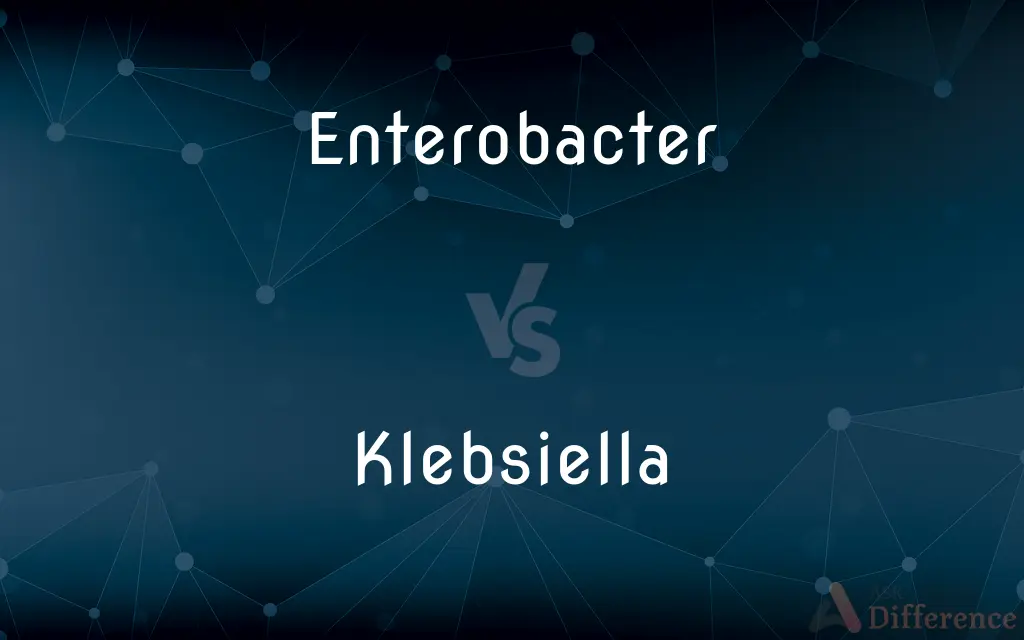Enterobacter vs. Klebsiella — What's the Difference?
By Tayyaba Rehman & Urooj Arif — Updated on April 25, 2024
Enterobacter is often linked to hospital infections, adaptable and resilient, while Klebsiella is known for causing severe pneumonia and infections in healthcare settings.

Difference Between Enterobacter and Klebsiella
Table of Contents
ADVERTISEMENT
Key Differences
Enterobacter species are a part of the Enterobacteriaceae family, known for their ability to acquire resistance to multiple antibiotics, making infections challenging to treat. They can be found in various environments, including soil, water, and the human gut. Klebsiella, another genus in the Enterobacteriaceae family, is notorious for causing severe infections, including pneumonia, bloodstream infections, and wound infections, particularly in individuals with weakened immune systems.
Enterobacter infections are often associated with healthcare settings, leading to conditions such as urinary tract infections, bloodstream infections, and pneumonia. The bacteria's adaptability and resilience to antibiotics pose significant challenges in clinical management. Klebsiella pneumoniae, the most well-known species, has developed resistance to many antibiotics, including carbapenems, making it a critical pathogen in healthcare-associated infections.
Enterobacter species are more diverse in terms of their environmental presence, being found not only in clinical settings but also widely distributed in nature. This diversity contributes to their reservoir of antibiotic resistance genes. While both Enterobacter and Klebsiella can cause healthcare-associated infections, Enterobacter's presence in various environments might contribute to its genetic diversity and antibiotic resistance mechanisms.
Klebsiella species, especially Klebsiella pneumoniae, have gained attention for their rapid spread of carbapenem-resistant strains. These strains pose a significant threat to public health due to limited treatment options. The thick polysaccharide capsule of Klebsiella not only aids in evading the host immune system but also contributes to the bacterium's ability to form biofilms, enhancing its survival in both hospital and community environments.
While both genera have mechanisms for antibiotic resistance, Klebsiella's resistance is often more pronounced and clinically significant due to the global spread of highly resistant strains. This has necessitated the development of new antibiotics and treatment strategies specifically targeting Klebsiella infections. In contrast, Enterobacter infections, while challenging, often have more available treatment options due to the bacteria's slightly lower profile in antibiotic resistance.
ADVERTISEMENT
Comparison Chart
Family
Enterobacteriaceae
Enterobacteriaceae
Common Infections
UTIs, bloodstream infections, pneumonia
Pneumonia, bloodstream infections, wound infections
Antibiotic Resistance
High, but variable
Often highly resistant, including to carbapenems
Environmental Presence
Widespread in nature and healthcare settings
Primarily in healthcare settings and human microbiota
Virulence Factors
Less defined, variable
Capsule, significant in evading host immune response
Compare with Definitions
Enterobacter
Part of Enterobacteriaceae.
Enterobacter species are commonly found in the environment and can cause hospital-acquired infections.
Klebsiella
Capsule Protection.
Klebsiella's thick capsule protects it from the host's immune system, aiding in infection.
Enterobacter
Antibiotic Resistance.
Enterobacter can rapidly develop resistance to multiple antibiotics, complicating treatment.
Klebsiella
Public Health Threat.
Carbapenem-resistant Klebsiella strains have become a critical public health issue due to limited treatment options.
Enterobacter
Healthcare Infections.
This bacterium is known for causing urinary tract and bloodstream infections in hospital settings.
Klebsiella
Antibiotic Resistance.
Klebsiella pneumoniae strains can be resistant to carbapenems, posing significant treatment challenges.
Enterobacter
Environmental Presence.
Enterobacter is found in soil, water, and the human gut, showcasing its diverse habitats.
Klebsiella
Healthcare Association.
It is often associated with severe healthcare-associated infections like pneumonia.
Enterobacter
Adaptability.
Enterobacter has a high capacity to acquire genetic material, enhancing its resistance and adaptability.
Klebsiella
Virulence.
The virulence of Klebsiella is heightened by its ability to form biofilms and resist phagocytosis.
Enterobacter
Enterobacter is a genus of common Gram-negative, facultatively anaerobic, rod-shaped, non-spore-forming bacteria of the family Enterobacteriaceae. It is the type genus of the order Enterobacterales.
Klebsiella
Klebsiella is a genus of Gram-negative, oxidase-negative, rod-shaped bacteria with a prominent polysaccharide-based capsule.Klebsiella species are found everywhere in nature. This is thought to be due to distinct sublineages developing specific niche adaptations, with associated biochemical adaptations which make them better suited to a particular environment.
Enterobacter
Any bacterium of the genus Enterobacter.
Klebsiella
A nonmotile, gram-negative, rod-shaped bacterium of the genus Klebsiella, such as K. pneumoniae, that causes pneumonia and other infections usually in patients with diminished immunity, such as diabetics and alcoholics.
Klebsiella
Any of the genus Klebsiella of rod-shaped bacteria, which cause many diseases in humans.
Klebsiella
A genus of nonmotile rod-shaped gram-negative enterobacteria; some cause respiratory and other infections
Common Curiosities
How do Enterobacter and Klebsiella develop antibiotic resistance?
They acquire resistance through genetic mutations and the transfer of resistance genes.
Why are infections caused by Klebsiella often more severe?
Klebsiella's capsule increases its virulence, making infections harder to clear.
What makes Enterobacter a concern in healthcare settings?
Its ability to develop resistance to multiple antibiotics makes it a challenge to treat.
What family do Enterobacter and Klebsiella belong to?
Both belong to the Enterobacteriaceae family.
Are Klebsiella infections contagious?
Yes, they can be spread in healthcare settings through direct contact or contaminated surfaces.
Do Enterobacter and Klebsiella have any beneficial roles in nature?
They can contribute to nutrient cycling in their natural habitats.
Can Enterobacter be found in healthy individuals?
Yes, it can be part of the normal gut flora without causing disease.
What is a significant difference between Enterobacter and Klebsiella in terms of environment?
Enterobacter is more widely found in nature, while Klebsiella is more restricted to healthcare settings.
Is Klebsiella pneumoniae the only Klebsiella species that causes infections?
No, but it's the most common and clinically significant species.
How are Enterobacter infections treated?
Treatment often involves antibiotics, but resistance patterns must be considered.
Can Enterobacter and Klebsiella infections be prevented?
Strict hygiene and infection control practices in hospitals can reduce the risk.
What role does the capsule play in Klebsiella infections?
It helps evade the immune response and is key to its virulence.
How significant is the threat of antibiotic resistance from these bacteria?
It's a major concern, especially with Klebsiella's resistance to carbapenems.
What makes Klebsiella a critical pathogen in healthcare-associated infections?
Its high level of antibiotic resistance and ability to cause severe infections make it particularly dangerous in healthcare settings.
Share Your Discovery

Previous Comparison
Parkway vs. Driveway
Next Comparison
Flap vs. FlutterAuthor Spotlight
Written by
Tayyaba RehmanTayyaba Rehman is a distinguished writer, currently serving as a primary contributor to askdifference.com. As a researcher in semantics and etymology, Tayyaba's passion for the complexity of languages and their distinctions has found a perfect home on the platform. Tayyaba delves into the intricacies of language, distinguishing between commonly confused words and phrases, thereby providing clarity for readers worldwide.
Co-written by
Urooj ArifUrooj is a skilled content writer at Ask Difference, known for her exceptional ability to simplify complex topics into engaging and informative content. With a passion for research and a flair for clear, concise writing, she consistently delivers articles that resonate with our diverse audience.














































